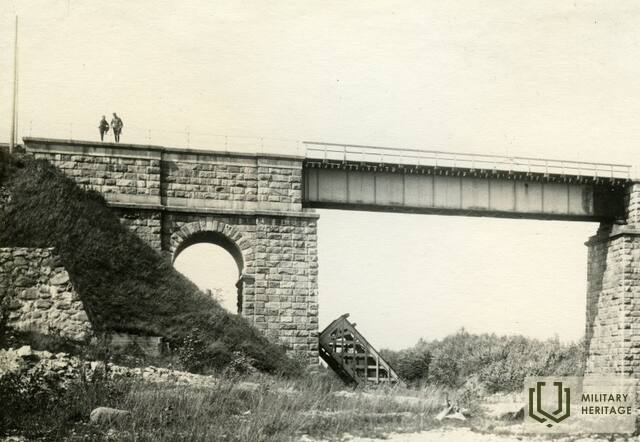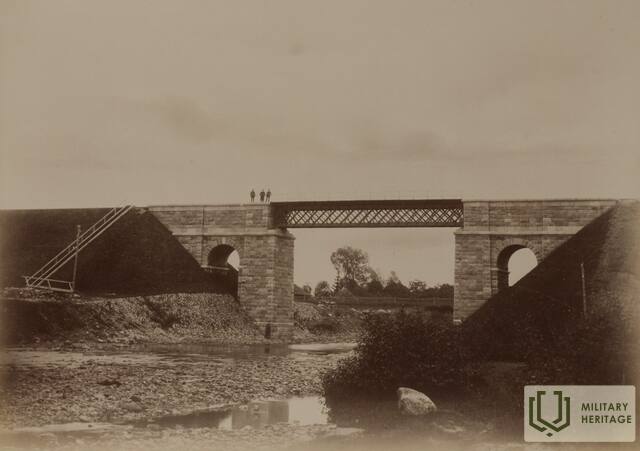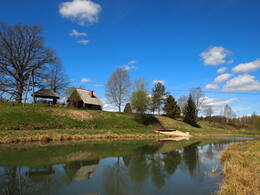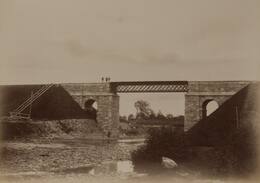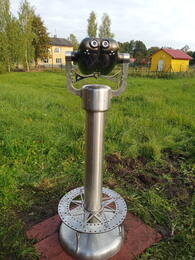Schlacht von Cesis an den Ufern von Amata
An der Brücke über die Amata greift eine deutsche Landeswehr einen zu Verhandlungen eingetroffenen estnischen Panzerzug an. Esten eröffnen das Feuer, Deutsche werden geschlagen und der Panzerzug fährt zurück nach Cēsis.
Eine völlig unerforschte Seite in den Schlachten von Cēsis ist eine Kollision an der Brücke über den Fluss Amata am Abend des 5. Juni 1919. Hier offenbart die deutsche Landeswehr seine wahren Absichten. Bis dahin behaupten die Deutschen in den Gesprächen, dass es in Cesis eine Rote Armee (eigentlich die Armeen Nordlettlands und Estlands) gibt und die deutsche Armee in Ieriķi auf ihren Angriff wartet. Der estnische Panzerzug Nr. 2 mit seinem Kommandanten, Hauptmann Lepp - im Auftrag des Oberbefehlshabers General Laidoner - wird auf dem Bahnhof Ieriķi zu Gesprächen führen. Die Deutschen kommen gar nicht und schicken eine Nachricht, dass sie südlich der Brücke über Amata auf die Unterhändler warten. Kārlis Dzirkalis, Soldat der Cēsis-Schulkompanie, wird als guter Kenner der Gegend dem estnischen Team zugeteilt. Es gibt auch zwei Oberste auf der Rüstung - den alliierten Gesandten Green und den Estonian Reek. Der Zug hält weiter von der Brücke auf der Nordseite (Cēsis). Sapier Lieutenant Lutsaar geht mit einigen Männern, um zu überprüfen, ob die Brücke nicht vermint ist. Commander Leps und beide Colonels folgen 200 Schritte hinter den Pionieren.
"Auf der anderen Seite der Amata-Wiesen grasen deutsche Streitwagenpferde. Rundum völlige Stille. Aber als der Pionier nach rechts unter die Brücke geht, um den Grund zu sehen, wird am gegenüberliegenden Flussufer das Maschinengewehrfeuer eröffnet. Beide Colonels und Capt. Leps warfen nach links. Im nächsten Moment laufen mehrere Infanterieketten aus dem jungen Pinienhain und eilen mit Granaten in der Hand herbei, um den Zug zu fahren.“
Aus den Erinnerungen von Oberst Nikolai Reck: „Um 19:00 Uhr eröffnete der Deutsche vom Waldrand auf der anderen Seite der Brücke das Feuer auf unsere Späher. Als die Deutschen getroffen wurden und die Späher, die eine weitere Kollision mit der Landeswehr hatten , bei dem der stellvertretende Stellvertreter Kontuss stürzte, in einen Zug gebracht wurden, mussten sie nach Cēsis zurückkehren.
Colds Battle Planner, Kommandant des Generalstabs der Nordlettischen Brigade (Oberstleutnant) Voldemārs Ozols: "Trotz aller Bemühungen der Entente und unserer Bemühungen, blutige Zusammenstöße zu vermeiden, geschah dies am 5. Juni. Für unseren bewaffneten Zug "Der Zug" angegriffen wurde, aber der Krieg zwischen Golca und uns hatte begonnen. Am 6. Juni um 3 Uhr morgens ging die Landeswehr in einen Schnellangriff, unterstützt durch starkes Feuer aus Artillerie, Minensuchern und Maschinengewehren." *
Oto Nonācs, Publizist und Persönlichkeit des öffentlichen Lebens und Herausgeber vieler Presseveröffentlichungen, schreibt 1934: „Die Ereignisse bei Cēsis sind nicht nur die Natur enger lokaler Schlachten, sondern von weitreichender internationaler Bedeutung; hat eine Linie für die weitreichenden Absichten gezogen der Deutschen, deren Erfüllung die Landkarte Europas stark verändert hätte, ist zum Erbe beider Nationen geworden, und dieses Bewusstsein ist in beiden Nationen tief verwurzelt.
* Zitate aus der Veröffentlichung des Museumsvereins von Cēsis "Als die Kanonen Līgo sangen ...", 1994.
Zugehörige Themen
Zugehörige Objekte
Rastplatz „Meža kaujas“ (südlich von Cēsis) – Hauptschauplatz der Kämpfe, an der Amata-Brücke;
Der Picknickplatz „Meža kaujas“ befindet sich an einem der Hauptschauplätze der Kämpfe bei Cēsis (dt. Wenden) – dicht an der Amata-Brücke. Besuchern werden Führungen und verschiedene Aktivitäten angeboten - Wanderungen und Ausflüge zu den wichtigsten Schauplätzen der Schlachten um Cēsis sowie Mannschaftsspiele. Im Anschluss können sich Besucher mit einer Kesselsuppe stärken. Die Eisenbahnbrücke über den Fluss Amata war im Unabhängigkeitskrieg von großer Bedeutung. Hier kam es zum ersten Aufeinandertreffen zwischen estnischen Truppen und der Landeswehr. Am 5. Juni 1919 entbrannte an der Eisenbahnbrücke über die Amata das erste Gefecht zwischen Panzerzügen der estnischen Armee und Einheiten der Baltischen Landeswehr. Die Landeswehreinheiten verminten in Erwartung eines Panzerzuges die Eisenbahnbrücke und bezogen beim „Amata“-Gesinde am Flussufer Stellung, um auf mögliche Kampfhandlungen vorbereitet zu sein. Die Amata-Brücke bildete die Frontlinie zwischen estnischen Truppen und den deutschen Kräften. Im Verlaufe der Schlacht von Cēsis räumte die Landeswehr in der Nacht auf den 23. Juni 1919 die Stadt Cēsis und zog sich auf den Flusslauf der Amata zurück. Auf ihrem Rückzug brannten deutsche Kräfte das lettische Vereinshaus in Cēsis nieder und sprengten die Amata-Brücke.
Eisenbahnbrücke über Amata
Das Hotel liegt in der Gemeinde Drabešu, Region Cēsis, in der Nähe des Erholungsortes "Meža kaujas".
Es gibt eine Eisenbahnbrücke über Amata.
Die Eisenbahnbrücke über Amata spielte während des gesamten Unabhängigkeitskrieges eine sehr wichtige Rolle, denn am 5. Juni 1919 fand hier das erste Gefecht der bewaffneten Züge der estnischen Armee mit den baltischen Landesver-Einheiten statt. Die Landeswehr, die wusste, dass sich ein bewaffneter Zug näherte, nominierte eine Eisenbahnbrücke und nahm eine Position beim Haus der Amatas am Flussufer ein, bereit für eine mögliche Kriegsführung. Die Brücke über Amata war die Grenze zwischen estnischen Streitkräften und den Deutschen.
Historische Beweise für die Ereignisse an der Amata-Brücke sind nicht erhalten. Da die Letten an diesen Ereignissen nicht teilgenommen haben, gibt es keine Erzählungen ihrer Erinnerungen, es gibt Erinnerungen von estnischen Soldaten und anderen Quellen. Man kann sagen, dass dies ein estnisch-amerikanischer Gemeinschaftskampf gegen die Landeswehr war, denn auf dem estnischen Panzerzug befand sich ein amerikanischer Offizier, der später auch im Zweiten Weltkrieg kämpfte. Im Allgemeinen nahmen viele zukünftige Offiziere und Kommandeure des Zweiten Weltkriegs an den Schlachten von Cēsis teil, insbesondere auf deutscher Seite.
Der estnische bewaffnete Zug kam am 2. Juni 1919 in Cēsis an, fuhr einen Tag später nach Ieriķi, wo Gespräche mit dem Vermieter stattfanden, die erfolglos blieben, und am 5. Juni, als sich der bewaffnete Zug wieder der Amata-Brücke näherte, eine Kollision mit Die Deutschen begannen. Einen Tag später nahm der bewaffnete Zug auch an den Kämpfen bei Cēsis teil, wo er den von der Belagerung bedrohten Soldaten der Schülerkompanie half. Obwohl die Deutschen versuchten, die Schienen abzubauen, um den Rückzug des Zuges abzuschneiden, gelang ihm der Rückzug über die Rauna-Brücke.
In der Nacht des 23. Juni 1919, während der Kämpfe von Cēsis, verließ der Landesver Cēsis und zog sich an die Amata-Flusslinie zurück. Als sie sich zurückzogen, brannten die Deutschen das Haus der lettischen Cēsis-Gesellschaft nieder und sprengten eine Brücke über Amata.
Virtual-Reality-Fernglas "Schlachten von Cēsis"
Die Schlacht von Cēsis war einer der wichtigsten Wendepunkte im Verlauf des lettischen Unabhängigkeitskrieges (1918 - 1920). Am 5. Juni 1919 begann die erste Phase der Schlacht von Cēsis mit einem Zusammenstoß zwischen gepanzerten Zügen der estnischen Armee und Einheiten der Landesvær in der Nähe des Bahnhofs Ierikai in der Nähe der Brücke über Amata. Zum Gedenken an dieses Ereignis wurde in der Nähe des Bahnhofs Ierikai ein touristisches Objekt geschaffen, das die Möglichkeit bietet, die Geschichte der Geschichte mit den Möglichkeiten der modernen Technologie - mit Hilfe der virtuellen Realität - zu erleben. Das fünfminütige Video „BATTLE FOR OFFICE BRIDGE“ ist täglich kostenlos im Virtual-Reality-Fernglas zu sehen. Videodauer: 5 Min., LV mit Untertiteln LV, ENG, EST und EU.




